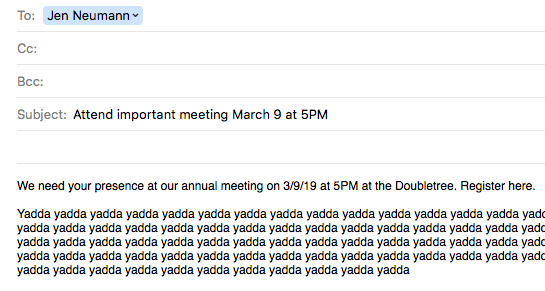Summary of this blog: you're writing too much. Keep it as brief as possible and then give them a link to more.
Have you ever shown up for an event or meeting or even a family dinner and there's some important nugget you didn't know about? And then you get this:
"Do you get our emails/read our blog/follow me on Facebook?"
"Well, yeah," you respond, "I do, but I don't get a chance to read everything."
As marketers or information sharers, it's frustrating because we struggle to put information out in every format that we possibly can, to catch the attention of our audiences and share what we think is vital information. But we often find out that our missives have gone unread.
Why? "Too long; didn't read."
Sometimes this feels almost offensive. We pour all our energies into our communications in the hopes that by putting as much info as possible out there, it's sure to get through one way or another. But the truth is we're giving way too much information most of the time. And trying to hit every communication outlet just short of nailing a Papal Bull to their front door is adding to the problem.
So what's the key to getting vital information out in front of your audience?
Understand where they live.
No, not literally. But where does most of your market get their information, and in what mediums and formats. Tweets? Facebook posts? Emails? By snail mail? Understanding your audience and where they get their info is key to your strategy being effective.
Don't assume they are waiting for your missive.
Let's be clear. They don't go to your blog or website without a compelling reason (a search for relevant info) and time to do so (and a link). They don't read your emails if they are too long or aren't readable on a mobile device and they are busy. They probably aren't opening your US Mail, or spending quality time reading it either.
Just the facts, ma'am. (Not that we are assigning binary gender.)
Keeping it short, with the absolute bare minimum of information needed, and then linking to more information is key. If it's an email, make it very easy for them to visually get the gist and the pertinent info, then link to your blog, website, registration, product page, etc. should they need more details. At a glance, your audience should know what they are supposed to do, when they need to do it, and how to do it.
When it comes to the deeper information, think of it as a pyramid—with the shortest and most succinct summary at the top, a layer of supporting information beneath that, and then, at the bottom, all the weeds, nerdy data, and additional context that 1% of your audience may find relevant.
The most important lines in your email—whether it's personal or a marketing email—is the subject and the first line. Most people barely read beyond that.

The same goes for social media. Make your image count and put everything the reader needs to know in the first line.
There's a lot more, but...hey, where did everyone go?
If you're still reading this, congratulations. You have an outstanding attention span. Thanks for hanging out so long. As mentioned above, there is a lot more to getting engagement from your audience. (Timing, placement, captivating content, etc.) But start by putting your words on a diet.
You're on a roll, huh? Keep your momentum going with these related blogs:
Rethink Your B2B Blogging Strategy—The dreaded "TL;DR" is one of two major problems faced by business bloggers. The other may be the exact opposite.
Motion in Email: Why Is My Inbox So Squiggly? - Cutting back on copy isn't the only way to make your emails more readable and enjoyable.
Digital Marketer's Checklist for GDPR - Speaking of email...is your business following opt-in/opt-out procedures as outlined by the GDPR?





Submit a Comment